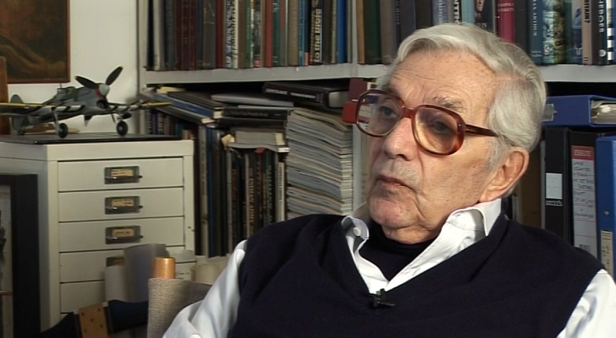NEXT STORY

'Order me a late tea'
RELATED STORIES

NEXT STORY

'Order me a late tea'
RELATED STORIES


|
Views | Duration | |
|---|---|---|---|
| 11. 'Little did we know how dangerous these bloody rockets were!' | 269 | 01:55 | |
| 12. Trying to avoid being hit by our own explosions | 227 | 02:00 | |
| 13. Finally getting commissioned | 193 | 01:33 | |
| 14. Defence mechanism against getting too emotional | 206 | 02:40 | |
| 15. 'I knew everybody was shooting at me' | 214 | 02:12 | |
| 16. Friendly fire | 192 | 04:43 | |
| 17. Losing fellow pilots on take off | 215 | 02:09 | |
| 18. The 'cab rank' | 184 | 03:10 | |
| 19. 'Order me a late tea' | 1 | 214 | 02:54 |
| 20. Norman Merrett | 1 | 175 | 03:44 |


There were two strange things that when I'm talking to you I remember. The one was when you were flying, attacking in formation, and one of your friends was hit and the aircraft maybe burst into flames or whatever it was, your immediate reaction was, 'Thank God it isn't me!' But after you landed, then the other reaction came in, and you know... it was not a nice reaction, obviously. In some cases, one had also to inform the family, and so on – it was awful. But the strange thing is that the first reaction was one of self-preservation, really.
And the other thing was that we had invented a system which was called Cab Rank, which I think he was writing about, too. When you had a section of four Typhoons sitting at the end of the airstrip, and I had a sort of map over my knees of the local area – you know, a grid map, and the ACP or whatever he was called used to fire a red thing up and we used to take off. But remember, the Germans were not more than six or seven miles away from us, so you had to circle to your operational height, which I think was 8000 ft or something, above the airstrip, and I had a map on my knees, a sort of grid map, and then a voice came over – it used to be either a controller in a forward tank who used to say, 'In 10 seconds there will be yellow or red or blue smoke' – whatever it was – 'go down and attack'. And you had your grid reference and you just flew to that... but you couldn't even... normally those tanks were hiding in trees or… so you didn't really see them until you went right down and then you attacked them. And you know, sometimes we had to fly two or three times a day doing that, and the German anti-aircraft became… and their 88mm guns became more and more... better even though they were, I think, pretty scared of the Typhoons, and... we had big losses.
Sir Kenneth Adam (1921-2016), OBE, born Klaus Hugo Adam, was a production designer famous for his set designs for the James Bond films of the 1960s and 1970s. Initially, he trained as an architect in London, but in October 1943, he became one of only two German-born fighter pilots to fly with the RAF in wartime. He joined 609 Squadron where he flew the Hawker Typhoon fighter bomber. After the war, he entered the film industry, initially as a draughtsman on This Was a Woman. His portfolio of work includes Barry Lyndon and The Madness of King George; he won an Oscar for both films. Having a close relationship with Stanley Kubrick, he also designed the set for the iconic war room in Dr Strangelove. Sir Ken Adam was knighted by Queen Elizabeth II in 2003.
Title: The 'cab rank'
Listeners: Christopher Sykes
Christopher Sykes is an independent documentary producer who has made a number of films about science and scientists for BBC TV, Channel Four, and PBS.
Tags: Wolrd War II
Duration: 3 minutes, 10 seconds
Date story recorded: December 2010 and January 2011
Date story went live: 15 August 2011